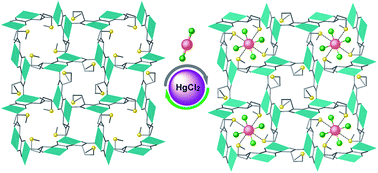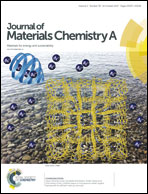Fine-tuning of the confined space in microporous metal–organic frameworks for efficient mercury removal†
Abstract
Offsetting the impact of human activities on the biogeochemical cycle of mercury has become necessary for a sustainable planet. Herein, we report the development of a water-stable and eco-friendly metal–organic framework, which has the formula {Cu4II[(S,S)-methox]2}·5H2O (1), where methox is bis[(S)-methionine]oxalyl diamide. Its features include narrow functional channels decorated with thioalkyl chains, which are able to capture HgCl2 from aqueous media in an efficient, selective, and rapid manner. The conscious design effort in terms of size, shape, and reactivity of the channels results in extremely efficient immobilization of HgCl2 guest species in a very stable conformation, similar to that of the enzyme mercury reductase. Thus, 1 enables the highly efficient removal of toxic HgCl2 from aqueous media and reduces the [Hg2+] concentration from the dangerous level of 10 ppm to acceptable limits of below 2 ppb in drinking water. The unusual combination of a low-cost straightforward synthetic procedure and high stability under environmental conditions, together with its ability to efficiently and rapidly remove poisonous mercury ions, places 1 among the most attractive adsorbents reported to date for the purification of contaminated water.

- This article is part of the themed collection: 2017 Journal of Materials Chemistry A HOT Papers


 Please wait while we load your content...
Please wait while we load your content...